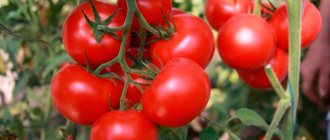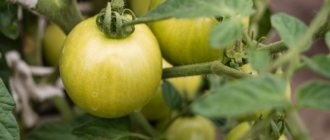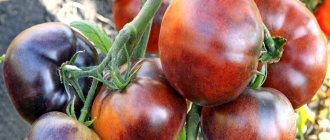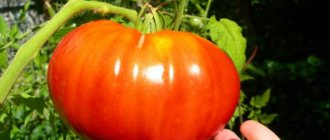» Vegetable growing » Tomatoes » Growing tomatoes Bogata Khata
0
1123
Article rating
Tomatoes are one of gardeners' favorite vegetables. They are easy to care for and have very high taste. They contain many vitamins. One of the most productive and versatile in use is the Bogata Khata tomato. The abundantly fruiting bushes are covered with a large number of beautiful tomatoes.
- Advantages and disadvantages of the variety
- Resistance to diseases and pests
- In what regions is it grown?
- Growing seedlings
- Preparing seeds for sowing
- Sowing seeds for seedlings
- Seedling care
- Transplantation into the ground
- Aftercare
- Watering
- Top dressing
- Bush formation
- Rules for storing fruits
- Reviews from gardeners
Growing tomato Bogata Khata
Description of the variety
The hybrid was bred by Ukrainian breeders in 1997. In the Russian Federation, the tomato was officially registered in 1999.
Bogata Khata tomatoes belong to the determinate type of plants. The maximum height of a standard bush does not exceed 35-40 cm. The culture, although undersized, is very strong. The carved foliage is light green in color and medium in size. The inflorescence is simple, containing up to 5 flowers. The fruit cluster is strong, well developed, and bears 3-5 small tomatoes. The compact plant does not produce stepsons, which greatly simplifies its cultivation.
Distinctive features
The hybrid is distinguished by its enormous vitality, which cannot be compared with ordinary varietal tomatoes. Bogata Khata F1 grows quickly, has strong immunity to diseases and pests and produces an excellent harvest. The crop is grown both in a greenhouse without heating, and in open ground and even on the balcony.
Fruit characteristics and yield
The tomatoes are dense, rounded, bright red in color. When cut, the tomato has pink-red flesh and 5 seed chambers. The fruits ripen 95-105 days after germination. The weight of a tomato reaches 100-120 g. Vegetable growers harvest up to 8 kg of crop from one square meter.
The fruits have a pleasant taste and aroma. The use of tomatoes is universal. The peel is thick and does not crack, so the tomatoes tolerate transportation well and are stored for a long time.
Tomato Bogata Khata - main features and 10 growing tips
The tomato Bogata Khata F1 came to me thanks to my mother - she grew a lot of seedlings and simply did not have enough space in the garden. I decided to try it, especially since the variety is low-growing and 6 plants fit per square meter - a small piece of the bed was enough. The tomatoes grew quite well, but I especially liked them in canned form - dense, neat, with a pleasant texture.
Tie up if necessary
Characteristics and description of the variety:
Tomato Bogata Khata
- Brought out by Ukrainian breeders in 1997. It was entered into the State Register of Plants of the Russian Federation two years later as a variety for film shelters and open ground. It grows normally in beds in warm summer conditions; in cooler regions it is better to place plants under film covers, especially since the bushes are small and it is enough to build a greenhouse that opens during the day.
- This is a determinate standard hybrid, so the packaging always has the designation F1. The height of the plants is usually from 30 to 50 cm, they are medium spreading, with 6 bushes per square meter. A garter is not necessary, but to prevent the flower clusters from falling to the ground under the weight of the tomatoes, it is better to tie them to pegs. Due to its small size, this option is often grown on balconies.
- Ripening dates are early. From the date of emergence to the harvesting of the first crop, it takes from 90 to 105 days. It all depends on external conditions and compliance with the watering and fertilizing regime. In greenhouses, the plant begins to produce crops earlier.
- The average weight of tomatoes is from 50 to 70 g. On the lower clusters, the fruits grow larger and weigh on average from 80 to 90 g. When ripe, tomatoes are red in color, the skin is of medium thickness and density. The shape is round or slightly flattened, most often smooth, sometimes there is slight ribbing.
Since the lower clusters can sink to the ground under the weight of the fruit, the soil can be mulched with straw or sawdust
- The yield per plant is approximately 1.5 kg. With a planting density of 6 plants per square, the figure is 9 kg per square meter. These are very good indicators for low-growing plants.
- The fruits tolerate transportation well and are stored for a long time. Even a ripe tomato can lie for more than a month in a cool, dark place without any problems.
- The taste is good. The variety is intended primarily for whole-fruit canning, as it is small in size and has a dense structure. But it is used fresh and for making juices, purees, etc.
- Resistance to most diseases is high. Plants are affected only in very unfavorable conditions and with gross violations of agricultural technology. Sometimes pests can be found on the bushes, but it is not difficult to fight them.
Although the bushes are not tall, in order to remove the load from the stem and prevent lodging of the bushes, they are tied to pegs. The author of the video talks about all the features of the variety and the conditions for its cultivation in accordance with the recommendations of the seed manufacturer.
Spray seedlings daily
You should only buy from stores with a good reputation; there is a lot of low-quality planting material in the markets. Choose products from well-known companies.
You won't be able to collect seeds yourself. This is a hybrid, so you will have to purchase them every year
Mulch the soil under the bushes
Carefully remove the plant from the container so as not to destroy the lump of earth. Make a hole in the garden bed the size of the root part.
Level the plant, cover it with soil and compact the surface
Why are there no ovaries?
- Unfavorable conditions in spring. If during flowering the temperature was below +15 degrees, then the pollen might simply not ripen.
- Shading of plants. Since the bushes are small, they are often covered by other crops, and without sun the ovaries form poorly.
Diseases and pests
Signs: caterpillars damaging foliage, ovaries, stems or even tomatoes.
Prevention and control: treatment with infusions of garlic, calendula or other fragrant herbs, collecting the caterpillar by hand. Use of insecticides
How to grow seedlings
To obtain an earlier harvest, Bogata Khata F1 tomatoes are grown through seedlings. Seeds are sown in small containers with fertile soil. When the plants grow stronger at home, they are transplanted to a permanent place of growth.
Seed preparation
First of all, pay attention to the presence of a stamp on the package with seeds. It indicates whether the manufacturer has pre-treated the seeds. Sometimes unprocessed seed material is sold. In this case, preparation is carried out independently. To do this, prepare a special solution, which contains one of the following substances:
- potassium permanganate;
- aloe juice;
- "Fitosporin".
The seeds are kept in the composition for 5-8 minutes, then washed thoroughly under running water. Grains are not planted wet. They are dried well, and only then will they be suitable for planting.
Container and soil
The most popular container for growing tomato seedlings is cups or tablets made of sphagnum peat (sphagnum reliably protects the roots from rotting). During transplantation, tomato seedlings are moved into prepared holes along with a peat container. This prevents damage to the roots, and the container itself gradually dissolves in the soil.
They also make their own containers. The most suitable ones are plastic cups or cut-off plastic bottles. They also cut cardboard boxes for juice or milk to the required level. The most suitable volume of available containers is 0.5 liters; diving is not carried out with such a container. If 100 ml cups are used, the seedlings are grown until 2-3 true leaves appear.
When transplanting to a permanent place, the seedlings are taken out of a plastic cup along with the soil.
Important ! When using plastic or other homemade containers, drainage holes are made at the bottom so that excess liquid does not accumulate after watering the seedlings.
Sowing
Seeds for seedlings are planted in late March - early April. The grains are laid to a depth of 1.5-2 cm, then the container is covered with transparent glass or film and left in this form until the first shoots appear. After this, the seedlings are transferred to the brightest windowsill or illuminated using phytolamps.
On a note. Even the slightest drafts can destroy young shoots, as the soil in the containers quickly cools. Therefore, take care in advance to ventilate the room without damaging the plants.
Growing and care
For good development of tomato seedlings at home, it is necessary to ensure:
- regular soil moisture;
- illumination of plants for 11-13 hours;
- daytime air temperature 18-20°C;
- temperature at night is not lower than 16°C.
The container with the plants is kept on the windowsill. The container is placed on a foam base, which protects the seedlings well from the cold.
When daylight is short, lighting in the form of phyto- or fluorescent lamps is evenly placed above the tomatoes. Lighting is turned on in the morning or evening.
Water tomato seedlings only with warm and settled water. The soil is always kept moist. When the tomato stems grow, they are carefully hilled up.
After the formation of 1-2 leaves, the tomatoes are transplanted into separate containers. Two weeks before transplanting the plants to a permanent place, the seedlings begin to harden. To do this, take it out onto the street or balcony every day: in the first days for 2 hours, then the time the plants spend in the fresh air is gradually increased.
Planting seeds
To grow Bogata Khata tomatoes, you must first obtain seedlings. At home, the seeds are placed in small containers with fertile soil. When the plants get stronger, they are transferred to the garden bed. In warm regions, planting seeds in a permanent place is allowed.
Preparatory stage
Tomato seeds are planted in light fertile soil. It is obtained by combining equal amounts of garden soil and humus. It is better to prepare the substrate for tomatoes in the fall and keep it at sub-zero temperatures on the balcony or in the refrigerator.
To plant tomatoes, take boxes 10-12 cm high. Tomatoes develop well in peat pots or tablets. This method of planting allows you to avoid picking plants. You can use special cassettes with cell sizes of 4-6 cm.
Tomato seeds also need to be processed before planting. The material is placed in a damp cloth and kept warm for 1-2 days. This stimulates the germination of planting material. Before planting, the planting material is left for half an hour in a solution of the drug Fitosporin.
Work order
After processing the soil and seeds, planting work begins. Planting dates depend on the region where tomatoes are grown. In the middle zone, work begins in the first ten days of March, in cool climates - at the end of February.
The procedure for planting seeds of the Bogata Khata variety:
- The boxes are filled with moistened soil, and the substrate is watered in peat cups.
- Tomato seeds are placed on the soil surface in increments of 2 cm. When using peat pots, 2 seeds are placed in each of them.
- Peat or soil is poured on top with a layer of 1 cm.
- Cover containers with tomatoes with plastic wrap.
Depending on the room temperature, tomato seed germination takes 5-10 days. When seedlings emerge, the containers are moved to the windowsill, and the seedlings are provided with the necessary microclimate.
Seedling care
For tomatoes to develop at home, a number of conditions are provided:
- daytime temperature 18-20 °C;
- temperature at night is not lower than 16 °C;
- backlight for 11-13 hours;
- regular soil moisture.
Boxes with tomato seedlings are kept on the windowsill. The containers are placed on a foam base, which will protect the plants from the cold.
When daylight hours are short, lighting is installed above the tomatoes in the form of fluorescent or phytolamps. Lighting is turned on in the morning or evening.
Bogata Khata tomatoes are watered with warm, settled water. The soil is kept moist. When the tomatoes grow, their stems are carefully hilled up.
What not to do: mistakes when laying laminate flooring with your own hands
When 1-2 leaves develop, the tomatoes are distributed into separate containers. When grown in cups, the most developed plant is left.
2 weeks before transferring to the garden, the tomatoes begin to harden. Plants are transferred to the balcony for 2-3 hours. The period of stay in natural conditions is gradually increased.
How to grow tomatoes
Proper cultivation of Bogata Khata tomatoes involves timely moistening, loosening the soil and periodically weeding the beds to remove weeds. Although the crop has good disease resistance, gardeners still treat the soil with a weak solution of potassium permanganate.
Landing
The seedlings are transplanted into the garden bed 60 days after sowing the seeds. Work is carried out when the soil warms up well, in May - June. The area for tomatoes has been prepared since autumn. The culture is demanding on soil fertility and plenty of sunlight. Crop rotation is also important for tomatoes.
Good predecessors for culture:
- garlic;
- onion;
- cabbage;
- legumes.
Unwanted Precursors:
- potato;
- eggplant;
- pepper;
- tomatoes.
The soil is dug up and added to 1 square. m 3-4 kg of compost and 25 g of superphosphate and potassium salt. In spring, the soil is loosened with a rake.
Tomatoes are planted in 20-centimeter holes at a distance of 40 cm from each other, and a gap of 50 cm is left between the rows. The roots are covered with soil and watered abundantly.
Care
With regular care, the culture develops well. Plants are watered and fertilized in a timely manner. The low-growing variety does not need pinching. When fruiting occurs, only the lower leaves are plucked off.
Plants are tied to a small wooden or metal support. To prevent diseases and pests, the crop is sprayed with biological products. In greenhouse conditions, humidity levels are controlled by opening or closing two opposing windows and doors.
The frequency of watering is set depending on weather conditions and the stage of crop development. After planting in a permanent place, the tomatoes are watered, then allowed to adapt for 7 days; during this period the crop is not moistened.
Until the ovaries form, 2 liters of water are added to the bush every 4 days. During flowering, plants require more moisture; one bush consumes 5 liters of water. During mass fruiting, watering is reduced. They do this so that the fruits do not crack.
Important ! Water the crop with warm water, which is poured strictly at the root in the morning or evening.
After watering the plants, the soil around the tomatoes is loosened and weeds are removed at the same time. If tomatoes are grown in a greenhouse, it must be ventilated. Soil moisture is maintained by mulching the beds with humus or peat.
For high yields of the Bogata Khata hybrid, fertilizers must be applied in a timely manner. Tomatoes are fed with solutions based on mineral or organic substances.
Tomatoes are fertilized according to the following scheme:
- 10 days after planting the plants in a permanent place;
- during the formation of buds;
- with the appearance of the first fruits;
- during the period of mass fruiting.
In the first stages of development, tomatoes are fed with mullein. It contains nitrogen, which promotes the formation of new shoots.
The next feeding is carried out with solutions that contain potassium sulfate and superphosphate. 25 g of each substance are stirred in 10 liters of water. The resulting fertilizer is applied at the root of the tomatoes.
In cool weather, foliar feeding is used. The solution is prepared from phosphorus and potassium substances. Mix 10 g of each fertilizer in 10 liters of water. The crop is sprayed in the morning or evening.
Mineral and organic fertilizers for tomatoes alternate. The day before watering, add ash to the water. Also, as a fertilizer, it is incorporated into the soil during loosening. Wood ash saturates the crop with a complex of mineral substances.
Features of cultivation and possible difficulties
Growing Bogata Khata tomatoes is no different from cultivating other hybrid tomatoes. Although the plant has a good immune system, some difficulties may still arise when growing vegetables. Each gardener plants crops in his own way, and besides, the structure of the soil is different everywhere. Because of this, various problems arise.
When a plant's flowers and ovaries fall off, it means the bushes lack moisture or nutrition. To eliminate the problem, regularly moisten the soil with warm water. Depending on weather conditions, the amount of watering varies.
When growing tomatoes in a greenhouse, the cause of this problem is a lack of ventilation or rot in the fruit. Ventilation and systematic watering should be controlled.
Diseases and pests
The tomato has excellent resistance to diseases characteristic of the species. If a crop is affected by any disease, this means that the plants are receiving improper care. Possible diseases:
- Dry spot is a fungal disease that is treated by spraying with fungicides and antifungals.
- Cracking tomatoes. This happens due to improper watering. In this case, their frequency is reduced.
Pests and their control:
- Scoop . Since this insect does not like medicinal plants, calendula is planted next to the tomatoes. The bushes are sprayed with garlic infusion (200 g of grated garlic or onion are mixed well in 10 liters of water and allowed to brew for a day). Among the chemicals used, Intavir is used.
- Slugs . To combat this parasite, the soil around the plants is sprinkled with ash, lime, shag or tobacco chips. Also, remove weeds in a timely manner and mulch the bed with tomatoes.
- Colorado potato beetle . The pest is eliminated by spraying with an infusion of walnut, wormwood, garlic, elecampane or hemp leaves. The procedure is carried out once a week, the last one – 3 weeks before harvesting.
It is important to know! A soap solution is added to any of the above products for stickiness: grated soap is dissolved in a container of water.
Gentle care
Description of care requirements:
- The land must be fertile. To do this, you need to fertilize it, add sand, manure, and check for acidity;
- Watering should be sufficient, twice a week;
- When planting, it is worth considering that the distance is important in order to get to the bushes normally and for normal lighting;
- The soil must be periodically loosened, mulched, and hilled without damaging the roots;
- There should be no weeds in the tomato bed; they must be destroyed at the roots in a timely manner, as they take all the nutrients from the vegetables;
- For prevention, it is necessary to spray the bushes with special means so that they do not get sick and harmful insects cannot overcome them.
The yield of this variety can be increased only by careful care of the bushes.
It is important to remember about fertilizing for growth and fruiting
Advantages and disadvantages
Vegetable growers prefer this hybrid for its positive qualities:
- precocity;
- high productivity;
- ability to grow even on a balcony;
- transportability of fruits;
- long-term storage;
- resistance to temperature changes;
- good immunity to diseases;
- excellent taste;
- versatility in application;
- compactness of bushes.
The main disadvantage of the F1 hybrid is that you cannot collect seeds from your own harvest. Also, some gardeners are not satisfied with the size of the fruit, but this disadvantage is compensated by the fact that the tomato is excellent for preservation.
Peculiarities
This hybrid, unlike other tomatoes, ripens quite quickly after sowing and transplanting into the ground. It is possible to grow the plant at home in the absence of a personal plot - on a windowsill, loggia and balcony. It easily tolerates various diseases that are found in crops of this variety. Remarkable ratio of crop size and yield. It is important to know that the current tomato variety is capricious about all kinds of fertilizing. If you do not fertilize the soil in a timely manner, do it more than a hundred times, the plant will stop bearing fruit and may completely wither away.
It is important to fertilize over a long period of time in the form of granules containing potassium and nitrogen. Yes, it is necessary to loosen the soil. Lack of proper care will lead to the loss of the tomato’s taste, which will negatively affect its use in various dishes. The vegetable will acquire a neutral gravity or no gravity at all. Iner is not suitable for further dilution. Unfortunately, such selections will bring a good harvest in the next generation.
Reviews
Vegetable growers speak positively about Bogata Khata tomatoes. This hybrid has more advantages than disadvantages.
Anna, Bryansk: “My dacha neighbor always praised her tomatoes. I also decided to grow a hybrid of Bogata Khata tomatoes. Shoots appeared quickly, the crop was grown in a greenhouse. The plant is quite productive for its size. The fruits are very tasty and aromatic. Compact bushes save a lot of space in the garden. I prepared so much preserved food that I later distributed it to relatives. I really liked the hybrid and will continue to plant it.”
Svetlana, Ufa: “For several years in a row I have been growing tomatoes for sale. I always buy new productive varieties that do not require special care. Based on its characteristics, I chose the hybrid Bogata Khata. I liked that the crop is an early ripening tomato. The fruits have an excellent presentation, as in the photo of the packaging with seeds, and most importantly, they are stored for a long time.”











